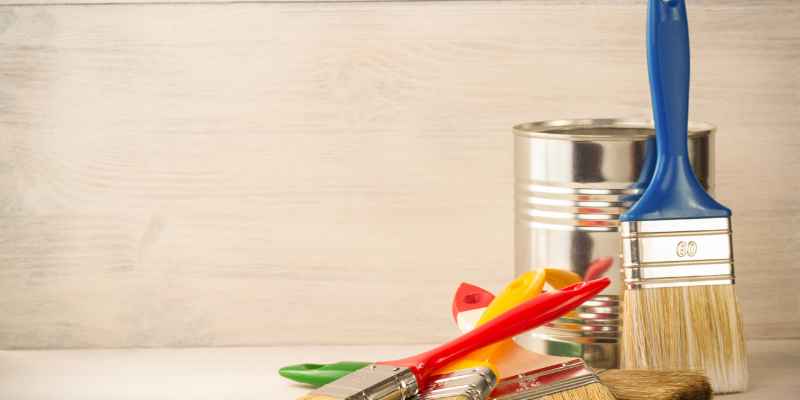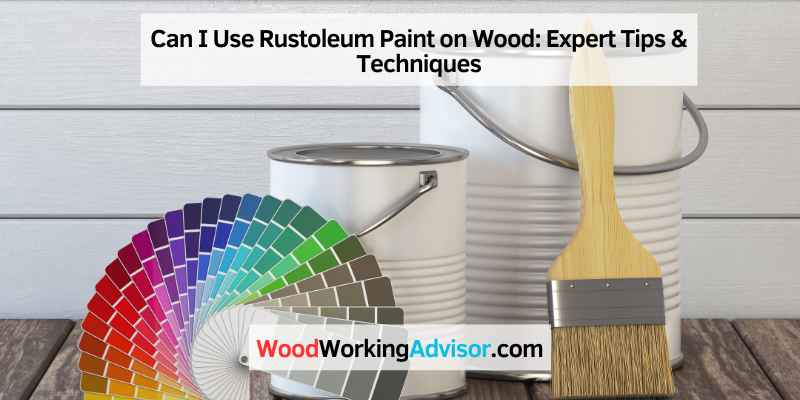Yes, you can use Rustoleum paint on wood. It is recommended to use a primer or a thin mist coat before applying it to ensure better results.
Can Rust-oleum Paint Be Used On Wood?
Yes, Rust-Oleum paint can be used on wood. It offers a wide range of durable and high-quality paint finishes suitable for wood furniture, home décor, and crafts. To ensure the best adhesion and finish, it’s recommended to sand the wood and apply a primer before applying the Rust-Oleum paint.
Exploring Rust-oleum Paint Varieties
When it comes to painting wood, Rust-Oleum offers a wide range of paint varieties that you can choose from. Whether you’re looking for a high-end finish or a more traditional sheen, Rust-Oleum has got you covered.
Their Universal Spray Paint line, for example, comes in premium finishes such as aged metallic, pearl metallic, and forged hammered. These options make it an excellent choice for spray painting wood furniture, home décor, crafts, and more. So let’s dive into the benefits of using Rust-Oleum paint on wood.
Benefits Of Using Rust-oleum Paint On Wood
Using Rust-Oleum paint on wood can bring numerous benefits to your painting projects. Let’s take a look at some of the advantages it offers:
Durability and Protection:
Rust-Oleum paint is known for its durability and long-lasting protection. When applied to wood, it forms a resilient barrier that helps shield your surfaces from the elements. This can be particularly beneficial when painting outdoor wood furniture or structures that are exposed to harsh weather conditions.
Versatility:
One of the great things about Rust-Oleum paint is its versatility. You can use it on various wood surfaces, whether they are unfinished or previously stained or painted. This flexibility allows you to give a fresh new appearance to a wide range of wooden pieces, from tables and chairs to cabinets and doors.
Smooth Finish:
Rust-Oleum paint is known for providing a smooth and professional-looking finish. It helps to mask any imperfections in the wood and creates a flawless surface. This makes it a great choice for both DIY enthusiasts and professionals who want to achieve a high-end look.
Easy Application:
Another advantage of using Rust-Oleum paint on wood is its ease of application. Whether you decide to use a brush, roller, or spray, the paint goes on smoothly and evenly, ensuring a hassle-free experience. This makes it suitable for both beginners and experienced painters alike.
Wide Range of Colors:
Rust-Oleum offers an extensive range of colors to choose from, allowing you to find the perfect shade to complement your style and existing décor. Whether you prefer classic neutrals or bold and vibrant hues, you’re sure to find a color that suits your taste and design vision.
In conclusion, Rust-Oleum paint can indeed be used on wood, and it provides numerous benefits for your painting projects. From its durability and protection to its versatility and ease of application, using Rust-Oleum paint can help you achieve a beautiful and long-lasting finish on your wooden surfaces. So why wait? Grab your paintbrush or spray can and start transforming your wood pieces with Rust-Oleum today.
Preparation Before Painting
Before you begin painting wood with Rustoleum, proper preparation is essential to ensure a smooth and long-lasting finish. Following these essential steps for preparing the wood surface and choosing the right primer will help achieve a professional-looking result.
Essential Steps For Preparing Wood Surface
1. Clean the Surface: Thoroughly clean the wood surface to remove any dust, dirt, or grease that could affect the paint adhesion. Use a mild detergent and water, then allow the wood to dry completely.
2. Repair Imperfections: Fill any cracks, holes, or imperfections in the wood with a suitable wood filler and sand it smooth once dry, ensuring a uniform surface for painting.
3. Sand the Wood: Lightly sand the wood surface with fine-grit sandpaper to create a smooth and slightly rough texture, promoting better paint adherence. Remove any sanding residue before painting.
Choosing The Right Primer
Selecting the appropriate primer is crucial for enhancing the adhesion and durability of the Rustoleum paint on wood. Here are key considerations:
- Wood Type: Choose a primer specifically formulated for the type of wood you are painting, such as pine, oak, or cedar, to optimize the bonding and prevent tannin bleed.
- Stain Blocking: If the wood has existing stains or discolorations, opt for a primer with excellent stain-blocking properties to ensure they do not bleed through the paint.
- Compatibility: Ensure the primer is compatible with Rustoleum paint. Consider using a Rustoleum primer specifically designed for wood surfaces for optimal results.
Application Techniques
When applying Rust-Oleum paint on wood, using the proper application techniques can make a significant difference in achieving a smooth and long-lasting finish. Here are the essential guidelines for applying Rust-Oleum paint on wood and tips to ensure a flawless result.
Proper Method For Applying Rust-oleum Paint On Wood
Before beginning the painting process, it’s crucial to prepare the wood surface adequately. This involves cleaning the wood to remove any dirt, dust, or grease using a mild detergent and water. Sanding the wood with fine-grit sandpaper will help create a smooth surface for the paint to adhere to.
Once the surface is clean and smooth, apply a suitable primer to the wood to enhance adhesion and ensure an even finish.
Tips For Achieving A Smooth Finish
When it comes to applying Rust-Oleum paint on wood, using a high-quality paintbrush or a paint spray system can significantly impact the final result. It’s essential to apply the paint in thin, even coats, allowing each coat to dry thoroughly before applying the next. This will help prevent drips, runs, or an uneven texture. Additionally, maintain consistent brush strokes or spray patterns to ensure an overall uniform finish.

Compatibility With Different Wood Types
When it comes to painting wood with Rust-Oleum paint, it’s important to consider the compatibility with different wood types. Not all woods are created equal, and the type of wood you’re working with can affect how well the paint adheres and the overall finish of your project. In this article, we’ll explore the best wood types for Rust-Oleum paint and some of the issues you may encounter with specific wood species.
Best Wood Types For Rust-oleum Paint
When using Rust-Oleum paint on wood, some wood types are better suited for achieving a smooth and durable finish. Here are a few of the best wood types for Rust-Oleum paint:
- Pine: Pine is a popular choice for many DIY projects due to its affordability and ease of working with. It has a relatively smooth surface that allows the paint to adhere well and provides a good base for an even finish.
- Poplar: Poplar is another wood type that is commonly used for painting projects. It has a tight grain and smooth surface, making it suitable for achieving a clean and professional finish with Rust-Oleum paint.
- MDF (Medium Density Fiberboard): MDF is not technically a wood, but it is often used in woodworking projects. It has a smooth and uniform surface that is perfect for Rust-Oleum paint, as it provides a consistent and even finish.
Issues With Specific Wood Species
While Rust-Oleum paint can be used on various wood types, there can be some issues when working with specific wood species. Here are a few examples:
| Wood Species | Issue |
|---|---|
| Oak | The strong grain pattern of oak can sometimes be visible through the paint, resulting in a textured finish. |
| Maple | Maple wood can be prone to blotching when painted, requiring extra prep work to achieve a smooth finish. |
| Cherry | Cherry wood naturally darkens over time, which can affect the appearance of the paint color used. |
It’s important to note that these issues can be minimized with proper preparation and techniques. Sanding the wood, using a primer, and applying multiple thin coats of Rust-Oleum paint can help achieve a more desirable result.
Ultimately, the best way to determine the compatibility of Rust-Oleum paint with different wood types is to test it on a small, inconspicuous area before proceeding with your project. This will allow you to evaluate the adhesion and finish quality on your specific wood species.
Ensuring Longevity And Durability
Achieve longevity and durability by using Rustoleum paint on wood. Whether it’s furniture, home decor, or crafts, Rustoleum offers high-end finishes and a range of options to ensure a lasting and beautiful result. Apply a primer or mist coat before painting for optimal results.
Sealing And Protecting The Painted Wood Surface
Every wood surface painted with Rust-Oleum requires proper sealing to enhance longevity.
Maintaining Rust-oleum Painted Wood
Regular maintenance of Rust-Oleum painted wood is crucial for durability.
To ensure longevity and durability of Rust-Oleum painted wood:
– Apply a clear topcoat to seal the painted surface.
– Protect the wood from moisture and UV exposure.
– Keep the painted surface clean and free from debris.
– Avoid harsh chemicals that may damage the painted finish.
Properly sealed and maintained Rust-Oleum painted wood can withstand the test of time.
Creative Uses And Design Ideas
Discover the innovative ways to incorporate Rust-Oleum Paint on Wood and embark on inspiring DIY projects to elevate your home decor.
Innovative Ways To Incorporate Rust-oleum Paint On Wood
- Revamp old wooden furniture with a fresh coat of Rust-Oleum paint for a modern look
- Create unique wooden wall art pieces by using stencils and various Rust-Oleum paint colors
- Add a pop of color to wooden planters or outdoor furniture for a vibrant outdoor space
Inspiring DIY Projects
- Transform plain wooden crates into stylish storage solutions with Rust-Oleum paint
- Personalize wooden signs or plaques with intricate designs using Rust-Oleum paint pens
- Experiment with ombre effects on wooden surfaces for a trendy and artistic touch
Frequently Asked Questions Of Can I Use Rustoleum Paint On Wood
Is Rust-oleum Paint Good For Wood?
Yes, Rust-Oleum paint is great for wood. Choose from a variety of finishes for furniture, decor, and crafts.
Can Metal Paint Be Used For Wood?
Yes, metal paint can be used on wood, but it may require a primer or thin mist coat for better results.
Can You Use Rust-oleum Paint On Bare Wood?
Yes, Rust-Oleum paint can be used on bare wood. It is recommended to sand the wood and apply a primer before applying the paint for better results.
Does Rust-oleum Bond To Wood?
Yes, Rust-Oleum can bond to wood with proper priming and sanding techniques for best results.
Conclusion
So, can you use Rustoleum paint on wood? The answer is yes! By following the proper primer and sanding steps, you can achieve great results for your wood projects. Rustoleum offers a wide range of finishes and colors, making it a versatile choice for various wood surfaces.
Explore the possibilities with Rustoleum paint for your next wood project.


